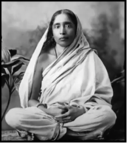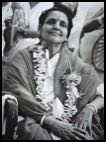Spiritual-Teaching.org
Letter #16 Continued
A mantra is a string of sounds that are meant deliberately to affect the mind and create a certain condition that aids the person saying the mantra. There are mantras for all occasions. For a person who follows the predominant south Saivite tradition, that is, worship of Lord Siva, a normal mantra that is given would be Om Namo Sivaya. One does not need a guru to check on the internet for the right pronunciation. It may not contain the imprimatur of a gurus blessing but it is a start.
Sri Ramana was also a Saivite as was known to give a phrase if persistently requested and considered that it would be of help to the supplicant. It is not just the word or phrase or prayer which is important, the grace of the guru who gives it is crucial. It is recorded that he gave the expression ‘Siva, Siva’. Sri Ramana also gave a single word such as iru (be) or summa iru (just be; at peace; quiet). There is a whole literature in Tamil spirituality connected to this latter phrase which signifies the highest state of consciousness which one can attain.
For those who follow the teachings of Sri Ramana the most important general prayer he gave us was Sri Arunachala Akshara Mana Malai (The Marital Garland of Letters). It is an appeal in 108 verses imploring the sacred hill Arunachala to grant not just solace but liberation from samsara.
It is a hymn of love demonstrating the travails and union of the soul with God in the form of Arunachala. It was written spontaneously by Sri Ramana one day as he circumambulated the sacred hill. The verses poured out of him in a stream of ecstasy. There are several translations of the Tamil hymn which give some idea of its beauty and profundity. 4
The Marital Garland of Letters grew on me over the years. At first, I did not understand but eventually, its profound meaning made an impact particularly when with the passing years a growing sensitivity to the palpable, physical majesty of Arunachala started to pervade my consciousness. From just an ordinary pile of rocks, it assumed epic proportions. It was as if one was breathing a different type of air that stimulated a sense of wonder.
Returning to the general and practical theme of this letter about how to pray. In verse six of Upadesa Saram (The Essence of Instruction) Sri Ramana states:
Rather than praising [God by singing hymns], [japa or repetition of his name is beneficial]; [rather than japa done in] a loud voice, [japa whispered faintly within the mouth is beneficial]; [and] rather than japa within the mouth, that which is done by mind is beneficial. This [mental repetition or manasika japa] is called dhyana [meditation]. 5
The simple mechanics of this verse are self-evident. From praise to japa, a mantra, to dhyana, silent meditation. It requires sustained effort, coupled with a determination to repeat again and again a mantra or a word. One aspect of the mind which works in one’s favour is the ability of the mind to repeat indefinitely if asked, a phrase, or a snatch of a song.
Quite often we do it unintentionally as the subconscious mind tries to tell us something important of which we are not aware. Intentional japa or repetition can lead us to pure meditation unembroidered by thought.
A prayer or a mantra can repeat itself automatically once we are determined that it should. It is as simple as that though the actual success depends on the intensity and sincerity of our determination. In Hindu philosophy, this is called a sankalpa.
The word sankalpa comes from the Sanskrit root kirp meaning ‘to come into existence’ and sam, meaning ‘completely’.
A conscious, continuous mantra or prayer is like the arms of a clock. Once the mechanism is activated, the arms go round and round until they run out of energy. In the same way, the instrument of prayer depends on how much energy we are prepared to give it. The miracle of prayer or a mantra is that if there is sufficient resolve, it will soon independently repeat itself, till it becomes natural like breathing. At the time when I practised a mantra, I was astonished by a mantra’s capacity to repeat itself independently of my will.
The mind is a machine and how we program it depends on our awareness. Think of a boat sailing on the ocean. The horizon is vast and the landmarks are almost nil. The future days of our life are the same; they are aspects of a journey about which we have little or no cognizance. How do we navigate this challenge? All we have to direct our boat impelled by the winds of change is a rudder. This is our facility of awareness.



